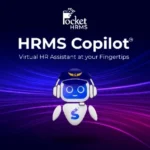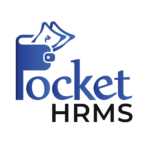
How HRMS Boosts Onboarding and Offboarding Efficiency
Table of Contents

Reading Time: 6 minutes
In a world of AI, tech leaders are pursuing full-fledged automation and incorporating machine learning into their business strategies. Among the most challenging tactical stages, hiring the right candidate for the right profile through the traditional process is a significant challenge. It is not time-consuming, but the process will also become extinct very soon, as employees won’t receive enough candidates as usual. Besides, in recruiting an employee, one of the most challenging phases of the employee lifecycle is onboarding and offboarding. And traditional manual approaches often lead to delays, miscommunication, and compliance issues.
This is where HRMS software plays a transformative role. HRMS’s cloud-based infrastructure, combined with comprehensive AI assistance, not only facilitates time management but also helps build employee engagement, ultimately enhancing productivity.
How HRMS Enhances Onboarding Efficiency
Instead of employee data handling using a standard spreadsheet, integrating an HRMS platform is a one-stop solution for future employee engagement and business profit. Let us describe how the HRMS portal enhances the onboarding efficiency of the right candidate within the estimated timeline. Additionally, the integration of cloud-based infrastructure and AI assistance enhances the efficiency of the HRMS portal.
1. Automated Documentation and Compliance
Using HRMS, new hires can submit documents digitally through the ESS portal, including their Aadhaar, PAN, and educational certificates. Additionally, employees can download their joining or appraisal letter through the HRMS. The system automatically validates information, ensuring compliance and reducing administrative burdens.
2. Streamlined Digital Workflows
HRMS welcomes the automation technique that primarily eliminates repetitive manual tasks and streamlines basic HR practices, such as offer letter generation, background verification, and policy acknowledgement. Besides, employers don’t have to review employee work manually; the system simplifies their workflow and generates feedback as well. This speeds up the process and minimises errors.
3. Self-Service Employee Portals
HRMS also provides self-service assistance to its employees, allowing them to efficiently process their required documents without seeking help from their employers. Using the ESS portal, employees not only submit their necessary documents but also download some essential letters from the HRMS employee portal.
Moreover, employees gain immediate access to company policies, training modules, and FAQs through a centralised portal, fostering independence and reducing reliance on HR for basic queries.
4. Faster Integration and Engagement
HRMS software is not only a simple documentation software, but it also provides a comprehensive HR practice, hence employers don’t have to look back to simplify the hiring or retirement process. In brief, the platform manages the entire employee life cycle. Moreover, the tools include orientation checklists, task trackers, and reminders that help managers ensure smooth role transitions and build engagement from day one.
5. Analytics-Driven Insights
HRMS software is a one-stop workforce solution that not only collects massive employee data but also secures it for future requirements. The platform collects the insights across various modules, including HRMS payroll, recruitment, attendance, performance, and offboarding, then standardises them to ensure accuracy and consistency.
Advanced HRMS platforms even leverage AI and machine learning to predict attrition, recommend training, and analyse sentiment from employee feedback, making HR analytics smarter and more actionable.
Also Read:
How HRMS Enhances Offboarding Efficiency
Offboarding is the last step of an employee’s employment. It is initiated through receiving the resignation from employees; however, the paperwork and exit interview are not the end. A smooth offboarding process includes resignation acknowledgement, handover, feedback collection, asset recovery, compliance paperwork, final settlements, communication, and access revocation, as well as gathering feedback.
In many cases, ex-employees become brand ambassadors, future clients, or even boomerang hires. However, manual offboarding processes can be time-consuming, error-prone, and inconsistent. Here, the Human Resource Management System (HRMS) plays a crucial role in making the offboarding process efficient, transparent, and respectful. Moreover, let’s see how the best HR software in India plays a key role in employee offboarding.
➔ Automated Exit Workflows
One of the biggest challenges employers face is streamlining the entire exit workflow across various departments, including HR, payroll, IT, and administration. An HRMS platform notifies the employers every minute about the employee’s exit procedure and automates the predefined exit workflows. Let’s discuss with an example: an HRMS portal automatically generates the acceptance or rejection of an employee’s resignation statement. Moreover, employees receive the autogenerated feedback form on the date of their departure. Additionally, the platform automates HR tasks, including manager approvals, IT clearance, and HR documentation. It eliminates delays, ensures accountability, and maintains a standardised process for all employees.
➔ Streamlined Knowledge Transfer
Employers often face challenges during their knowledge transfer sessions with employees. In the session, employees must upload project handover documents and client information to their employers. Delaying submission may cause hassle throughout the entire offboarding process. The HRMS portal ensures that employees receive automated notifications when uploading project handover documents. Additionally, the HRMS-associated tools come with features like task trackers, which track the entire project’s completion, review handover documents, and provide assistance. Managers can monitor progress and ensure that responsibilities are transitioned smoothly to the replacement staff. This minimises disruptions to operations and safeguards organisational knowledge.
➔ Efficient Asset Recovery
Tracking company-issued assets like laptops, ID cards, or software licenses can become complex without a proper system. IT heads and management often face challenges when collecting assets on time during periods of bulk employee departures. HRMS maintains a centralized record of assets allocated to each employee. During offboarding, automated checklists remind HR and IT teams to recover these assets. This not only ensures accountability but also prevents financial and data security risks associated with unreturned assets.
➔ Transparent Final Settlements
Full and final settlement are one of the most sensitive aspects of employee exits. It includes calculations of gratuity, provident fund, leave encashment, and reimbursements. And manual submission of everything can result in disputes or errors. An HRMS with AI assistance automates all the payroll calculations, ensuring accurate, timely, and transparent settlements. It enhances trust and reduces conflicts between employees and the organisation.
➔ Exit Feedback and Analytics
Collecting feedback during exit interviews is crucial to understanding why employees leave and how retention strategies can be improved. HRMS automates the collection of exit surveys and compiles the data into easy-to-read reports. By analysing patterns—such as recurring reasons for attrition within a particular department—organisations can proactively address workplace issues and enhance employee retention.
➔ Compliance and Documentation
Employee offboarding rules are constantly evolving in response to updated labour laws and compliance requirements. Employers get into trouble when they fail to stay up to date with legal compliance. HRMS ensures that all necessary documents, such as experience letters, tax forms, and compliance records, are generated and stored digitally. This reduces the risk of missing paperwork and protects the organisation during audits or legal reviews.
Also Read:
Key Benefits of HRMS in Onboarding and Offboarding
Both the processes of onboarding and offboarding are not only challenging but also lengthy. HRs spend more than half of their working hours managing employee hiring and retirement hassles. An HRMS platform with all the benefits of automated employee life cycle not only provides a sound sourcing of potential candidates for the required position but also maintains the entire employee life cycle till they retire. Nowadays, it has become mandatory for every company, whether it is a startup or an MNC. Hence, let’s see the benefits of integrating an HRMS for streamlining employee onboarding and offboarding.

1. Time Savings
The integration of HRMS, along with the adoption of automation, reduces administrative workloads and accelerates both the onboarding and offboarding processes.
2. Cost Efficiency
The HRMS and AI assistance not only minimises errors, eliminates onboarding and offboarding processing delays, and mitigates compliance-related risks, but also saves substantial costs.
3. Employee Experience
HRMS ensures a smooth transition that makes employees happy, as both the onboarding and offboarding processes are completed within the estimated timeline. Besides, it enhances trust, loyalty, and employer branding.
4. Data Security
Paperless onboarding or cloud-based offboarding, facilitated by HRMS and associated automation, ensures compliance with data privacy regulations by securely storing employee records.
5. Scalability
Whether for 10 employees or over 1,000 employees, the HRMS scales effortlessly without compromising efficiency.
Some essential Case Insights: How Leading Companies Leverage HRMS
➔ Infosys
With a massive workforce, Infosys utilises HRMS platforms earlier to digitise onboarding and streamline the process. New hires can complete joining formalities even before day one, allowing them to focus on training and role-specific tasks immediately.
➔ TCS (Tata Consultancy Services)
TCS itself developed their digital platform ‘ION’. It is an HRMS platform that caters to employees, providing onboarding, payroll, attendance, performance, and offboarding services for its global workforce. By automating processes, TCS reduces administrative overhead and ensures compliance across multiple geographies.
➔ Capgemini India
Capgemini India also integrates HRMS-driven workflows to streamline the entire employee life cycle, with a primary focus on the exit, onboarding, and offboarding processes for employees. It facilitates faster clearance, seamless handovers, and transparent settlements, while also collecting structured exit feedback.
End Note
The HRMS is not the only standalone solution for employee onboarding and offboarding. The system streamlines the entire employee life cycle. Hence, management doesn’t have to delve deeply into employee management in detail. Besides, the recent addition of cloud-based assistance and automation processes can ensure that every employee’s entry or exit is efficient, compliant, and dignified, thereby strengthening their employer brand and keeping doors open for future collaboration.








